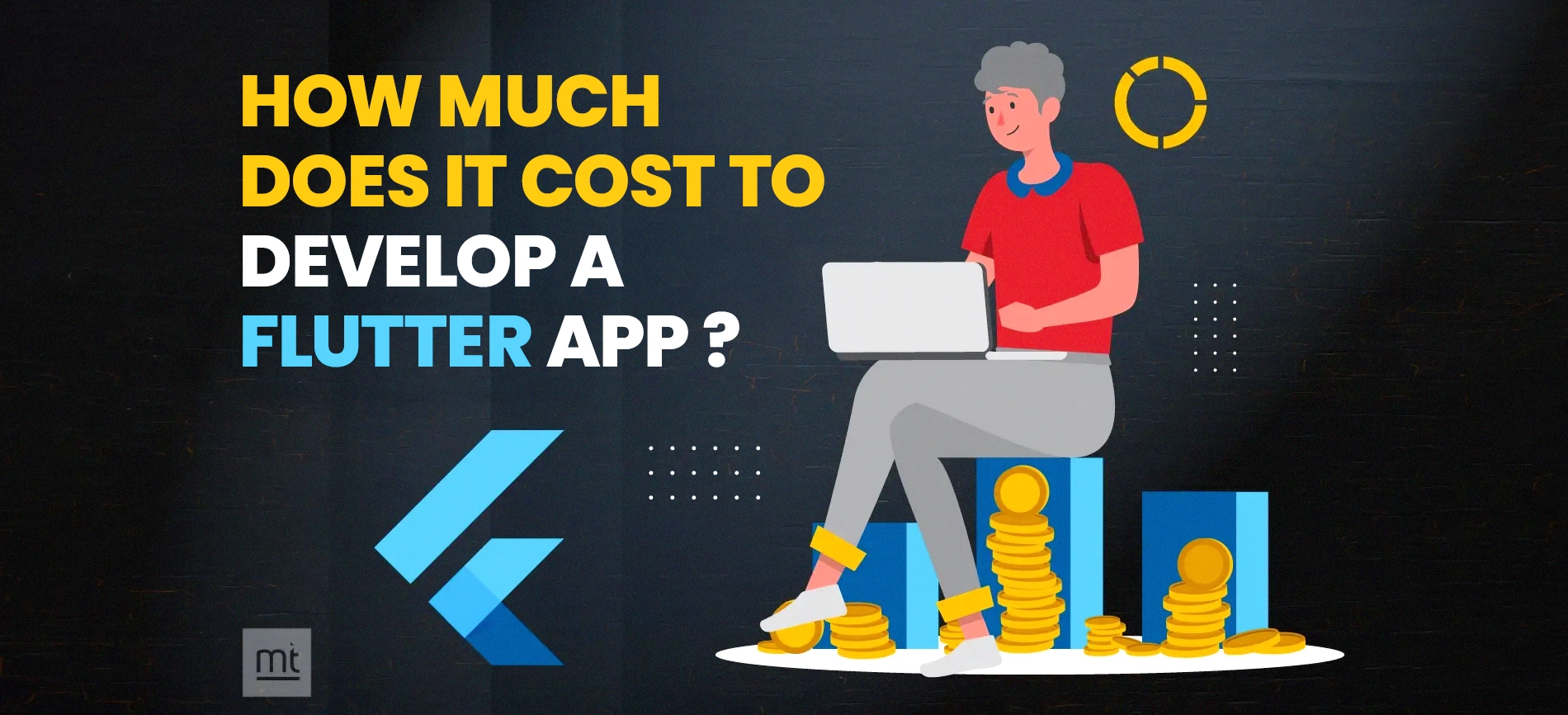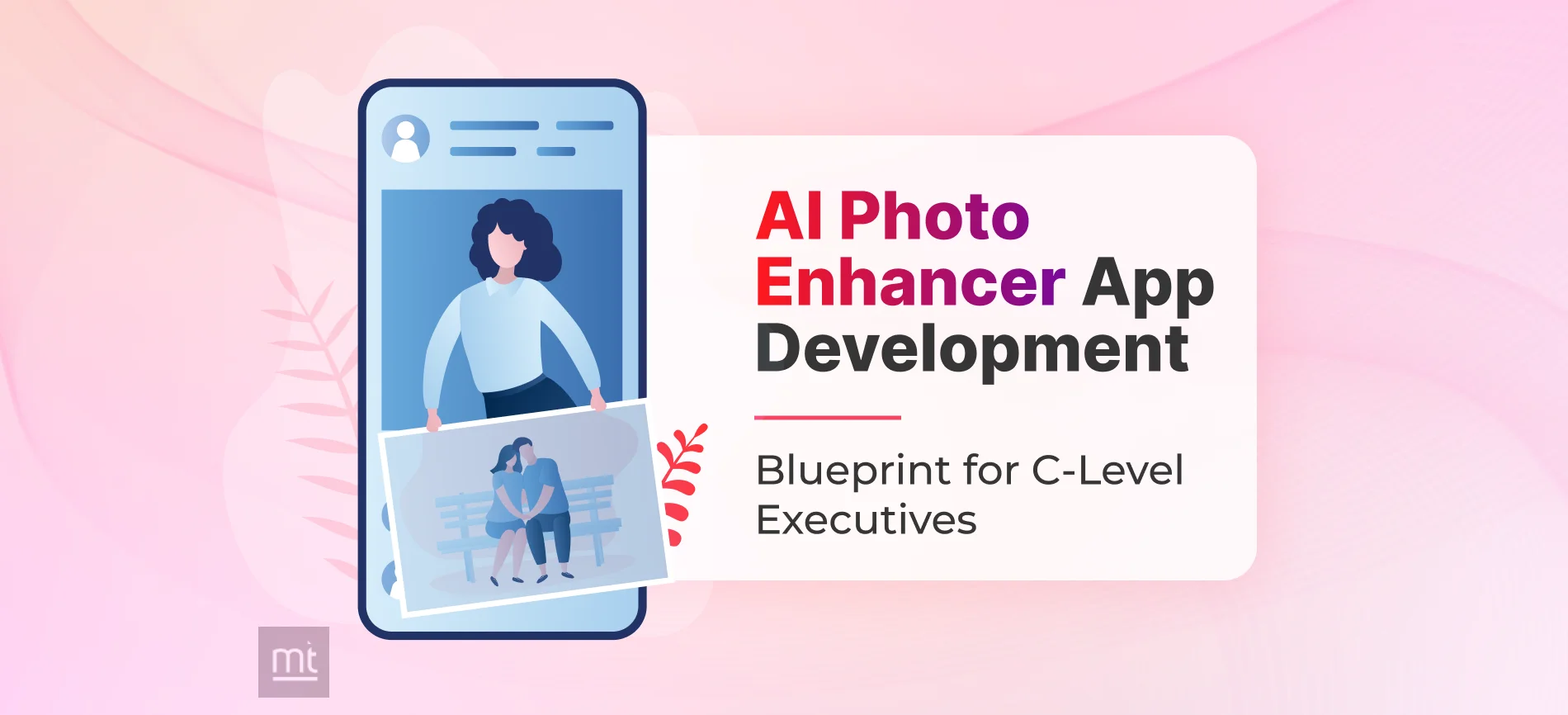Get Free Trial Week Developer Access, Try Before You Hire. Click Here to Claim Now
Key Takeaway:
- Planning to make a palmistry app like Life Palmistry? This blog covers the entire process.
- Find out how to build a palm reader app with the right features and tech stack.
- Get insights on how does a palm reading app work?
- You will also understand which features make a palmistry app stand out.
- Know exactly what is the cost to develop a palmistry app in today’s market.
Introduction:
If you are thinking about how to build a palm reader app like Life Palmistry? Then this blog is the perfect place to start. Palm reading, or palmistry, is one of an ancient art of interpreting the lines and shapes of a person’s hand to reveal personality traits, strengths, and even life predictions. With the moving digital age, even age-old practices like palm reading are going mobile, bridging tradition and technology. Research shows the global astrology app market was worth $4 million in 2024. It is expected to grow to $5 million by 2025, and could reach nearly $29.4 million by 2033. This means the market is growing very fast.
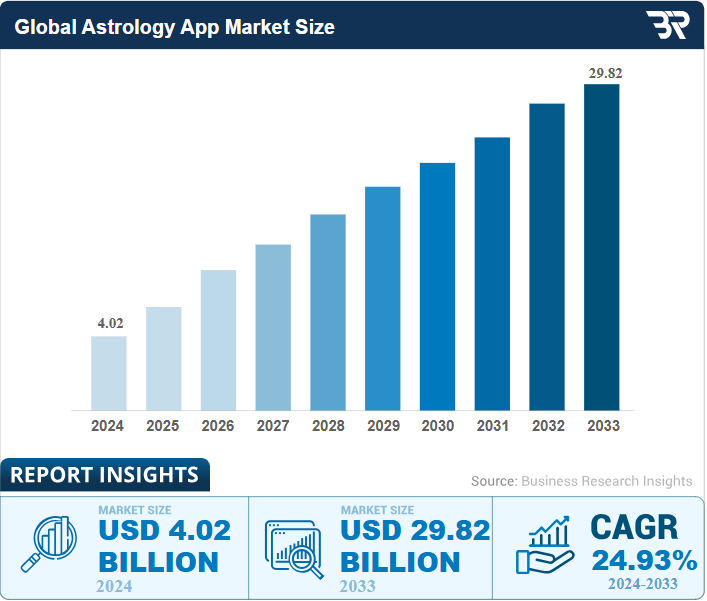
The U.S. psychic and astrology services industry generated $2.3 billion in 2024. Nearly 1 in 3 Americans explore astrology and palm reading apps yearly, while 46% prefer AI-driven predictions. As today more and more people are looking for palm reading apps for personal guidance and to solve their life problems, now is the perfect time to develop a palm reading app.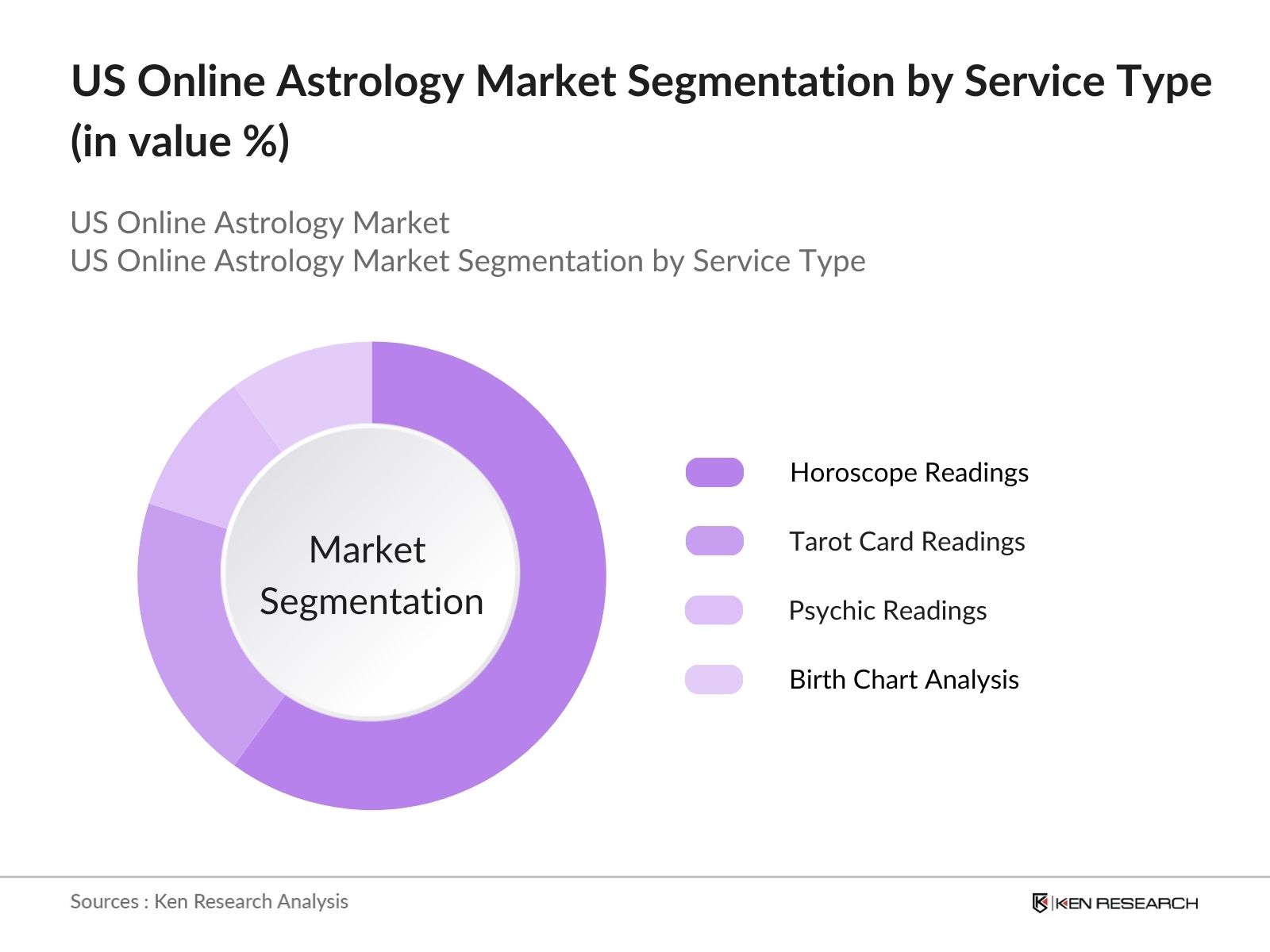
In this blog, you’ll learn how to make a palm reader app like Life Palmistry—from core features and tech stack to development cost and user insights. We’ll also explore how palm reading works digitally and what makes these apps so popular in today’s growing wellness industry.
How Does a Hand Reading App like Life Palmistry Work?
Palm reading apps like Life Palmistry use AI and machine learning to analyze the lines and features of your palm. You can simply take a clear photo from your phone’s camera and the app will analyze the key lines like the heart line, head line, life line, and fate line. It also studies their shapes, lengths, and how they connect to offer personalized insights about personality traits, love life, career direction, and even well-being.
The app fetches data from a palmistry database that is based on traditional beliefs. Based on this, it will generate personalized reports that show your personality, emotions, love life, or career path. While these apps don’t tell the future, they’re great for self-reflection and entertainment.
What Technologies Are Used to Build a Palm Reader App?
AI, machine learning, image recognition, mobile frameworks, backend and cloud services are the important technologies required to create a palm reader app. AI and ML to study palm lines. Image recognition helps scan and detect features of the hand. And frameworks like React, Flutter, a database, and cloud servers for app development and personalized reports.
Component | Technology/Tools | Purpose |
Frontend (Mobile) | Flutter, React Native, Swift, Kotlin | Cross-platform or native mobile app development |
Backend | Node.js, Django, Firebase | Handles logic, user data, and app operations |
AI/ML Models | Python (TensorFlow, OpenCV, PyTorch) | Palm line detection, pattern recognition |
Image Processing | OpenCV, MediaPipe | Scanning and analyzing palm images |
Cloud Services | AWS, Google Cloud, Azure | Hosting, AI model deployment, storage |
Database | MongoDB, PostgreSQL, Firebase Realtime DB | Storing user profiles, scans, and predictions |
Authentication | Firebase Auth, OAuth 2.0 | Secure login/signup options |
Push Notifications | Firebase Cloud Messaging (FCM), OneSignal | User engagement and updates |
Payment Gateway | Stripe, Razorpay, PayPal | For subscriptions, in-app purchases |
Analytics | Google Analytics, Mixpanel, Firebase Analytics | User behavior tracking and app performance |
What Are the Key Features of an AI-Powered Palm Reader App?
Apart from real-time scans to daily predictions, the Features of the palm reading app are responsible for the user experience. Your palm reading app must have an AI-based palm scan, real-time line detection, offer daily/ weekly predictions, mood detection, voice chat support, and essential features to keep users engaged. Here is the brief of the features of the AI-powered palm reader app.
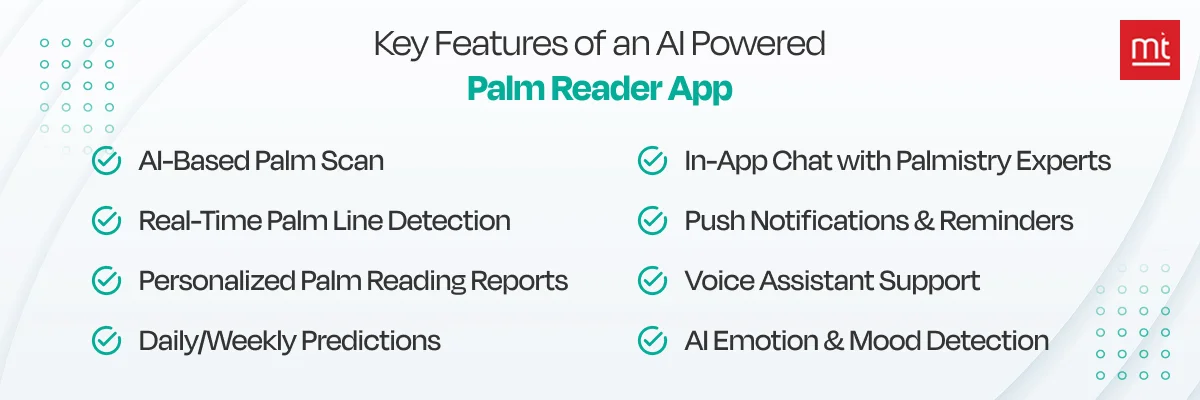
#1. AI-Based Palm Scan
This feature allows users to take a picture of their palm using their phone. The app will use AI to scan the image and understand key patterns and shapes. Based on the image clicked, the AI learns from thousands of palm samples to improve its accuracy over time.
#2. Real-Time Palm Line Detection
Once you upload the palm picture to the app, it will show important lines like the heart, head, life, fate lines, and more. This is done using image recognition and AI. Real-time detection ensures users get feedback without delays.
#3. Personalized Palm Reading Reports
It will then generate personalized user reports by analyzing the different lines. Every line means certain things in astrology; based on this, you will get an idea about your personality, love life, career paths, and possible strengths or challenges.
These are not 100% accurate reports, as these are based on traditional palmistry rules combined with data-driven AI learning.
#4. Daily/Weekly Predictions
This feature provides daily or weekly predictions based on the palm data and user behavior. As many users check the palm reading app regularly, it helps to keep users engaged by providing daily predictions and insights to users.
#5. In-App Chat with Palmistry Experts
Some users may want real human advice, so this feature connects them with live palm readers. It builds trust and adds a personal touch. Users can also ask follow-up questions or get second opinions on their AI results. You can also keep this as a paid consultation feature.
#6. Push Notifications & Reminders
Your palm reading app must send notifications about daily readings, special offers, or messages from experts. These gentle reminders will remind users to visit the app again and again.
#7. Voice Assistant Support
Voice assistant integration can be a useful feature for users who dont want to type and simply ask about their palm readings through voice. This is one of the convenient and modern technology in todays time.
#8. AI Emotion & Mood Detection
Some apps use facial recognition or behavior tracking to sense a user’s mood. Based on this, the palm reading report or app interaction adjusts tone or suggestions. For example, if someone seems stressed, the app will highlight relaxing aspects in their reading. This helps to create a more personalized and emotional experience.
How to Develop an AI Palm Reader App like Life Palmistry: Step-by-Step Guide
To build a palm reading app like Life Palmistry, first look into what users want. Next, focus on creating a good design, a user-friendly interface, and choose the right tech tools. Build the app’s core features, include smart AI to scan and analyze palms, and test everything carefully. Launch the app and promote it well. Here are your steps to build a palm reader app in the correct way.
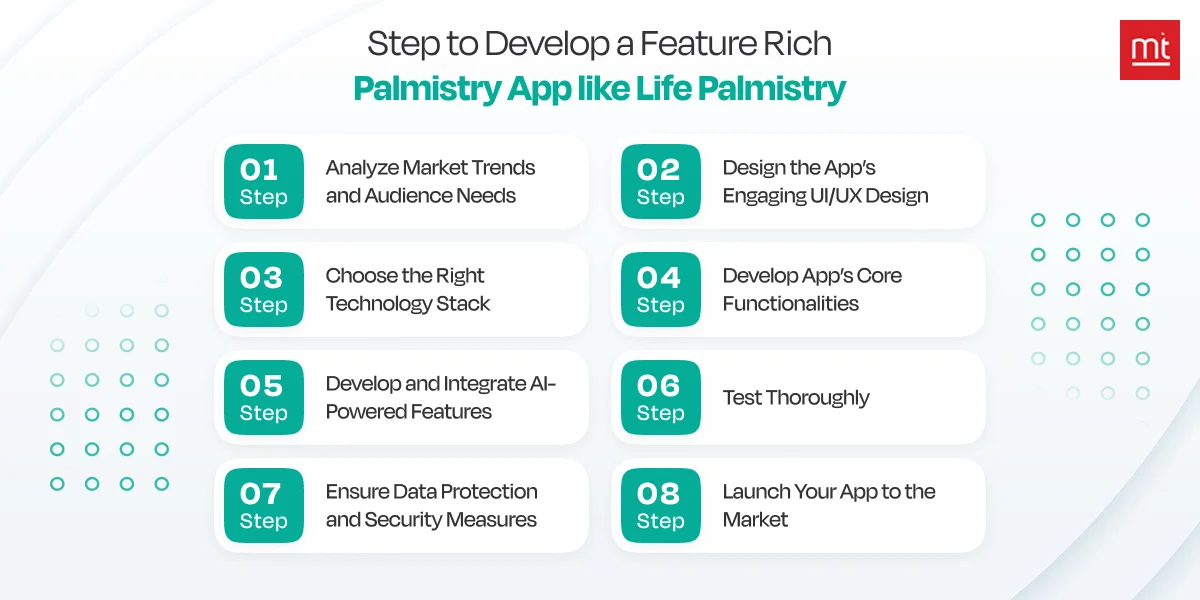
Step 1. Analyze Market Trends and Audience Needs
Before starting with AI-powered palm reading app development, do good research about the palm reading industry and competitors' apps that are currently available in the market. Check what users like, what they complain about, and which features are most popular. Read app reviews, and look at downloads and user behavior.
Also, research your target audience to know their expectations. Are your users spiritual, casual users, or just a curious generation who love to explore palm reading? By looking at the current situation of the palm reading market, competitors, and user’s expectations, you will be able to decide the right features, design, and marketing approach.
As today's curious Gen Z and millennial users seek personalized, engaging, and meaningful experiences, consider the questions below to make the most out of your research.
- What is the current market demand for AI-powered spiritual or self-discovery apps?
- Who is the target audience for an AI palm reader app, and what are their motivations?
- How do existing palmistry or astrology apps currently monetize their services?
- What unique selling propositions can differentiate an AI palm reader app in a crowded market?
Step 2. Design the App’s Engaging UI/UX Design
Once your research is done, you will have an idea about different competitors' app designs and user interfaces. Prefer a minimal design that looks decent and is easy to use. Createa design in such a way that users can easily find the main features of the app.
Use calming colors, clear instructions, and intuitive navigation. Users should be able to scan their palm or explore features without confusion. Good UI/UX builds trust and keeps users coming back. A clean layout, helpful icons, and clear calls to action will improve the overall experience and help your app feel both modern and welcoming.
Your palm reading app is effortless when it is used effortlessly by users. If you want to build trust along with a clean UI design, make sure you have clear answers for the below questions.
- How can the app's interface guide users seamlessly through the palm scanning and reading process?
- What interactive features can enhance user engagement and make the palm reading experience more immersive?
- How can the UI/UX design build trust and credibility, given the subjective nature of palmistry?
- What are the best practices for presenting complex palmistry interpretations in an easy-to-understand and visually appealing manner?
Step 3. Choose the Right Technology Stack
Depending on your requirements, future scope, and users’ expectations, choose frameworks and back-end tools. If you are targeting both Android and IOS audiences, then choose Flutter or React Native and back-end tools like Node.js or Django. TensorFlow or OpenCV can be the best AI and machine learning libraries for palm reading features. For hosting, storage, and notifications services, Firebase and AWS work wonders.
Moreover, you must focus on core AI capabilities, future updates, stability, and making the app responsive while you build an AI palm-reading application.
The performance of your app will depend on the technology you integrate, so make sure to get clarity on below questions to implement it right.
- What programming languages and frameworks are most suitable for developing a robust AI palm reader app?
- Which AI/ML libraries and tools are essential for accurate palm line detection and interpretation?
- Should the app primarily use on-device AI processing or rely on cloud-based AI for palm analysis?
- How can third-party integrations (e.g., payment gateways, analytics tools) be seamlessly incorporated into the tech stack?
Step 4. Develop App’s Core Functionalities
Now that you know your audience, design preferences, and technologies to use, it's time to start developing the app’s core functionality. Develop the core functionalities first, that i,s user registration, camera access to scan palms, storing images, and viewing results.
Make sure the scanning and analysis process is simple. Add options like user profiles, reading history, and settings. Your app must create value from day one users starts using it because first impression matters. Add chat support and daily reading notifications to keep users connected.
To make sure you deliver features that users want, you should ask these questions to your development team to make sure you are moving in the right direction.
- What are the fundamental features required for a minimum viable product (MVP) of an AI palm reader app?
- How will the app capture and process high-quality images of users' palms for analysis?
- What data points from the palm (e.g., major lines, minor lines, mounts, hand shape) will the app prioritize for interpretation?
- What backend architecture is necessary to support real-time palm analysis and personalized results?
Step 5. Develop and Integrate AI-Powered Features
AI and machine learning are the main things that help analyze and read the palm lines. You will need an experienced AI/ML developer for this. They must be able to apply suitable machine learning models to detect the main lines, such as life, heart, head, fate, and analyze them based on length, depth, and shape.
You can use traditional palmistry data to create personalized readings as other reputed astrology apps do. This way, you can provide better service with unique and engaging functionalities like a smart palmistry guide, allow users to chat with reputed palm readers, and many other ways.
Discuss the following things with your team and AI/ML developers to implement AI features in the right manner.
- How will the AI model be trained and continuously improved with diverse palmistry data?
- What natural language processing (NLP) capabilities are needed to generate insightful and personalized palmistry readings?
- How can the AI provide "evolving" readings based on changes in a user's palm over time?
- What advanced AI features, beyond basic readings, could enhance the app's value (e.g., comparison with friends, compatibility readings)?
Step 6. Test Thoroughly
Testing is one of the critical phases that will depend on your QA and tester team. Once every module of the app is developed, you must test each function and feature to ensure they work great. Try different phones, lighting conditions, and user actions. Check if palm scans are accurate and readings are delivered correctly.
Run functional, UI, and AI accuracy testing to identify bugs, speed-related issues, and ensure a smooth user flow. Also test security, loading times, and crash resistance. The best thing you can do is release a beta version first for a small group of users to collect early feedback and improve your palm reader app accordingly.
Discuss these questions with your QA and testing teams to make sure you cover every aspect of app testing.
- What specific testing methodologies are vital for validating the accuracy and reliability of AI palm reading interpretations?
- How can the app be tested for performance under various network conditions and device specifications?
- How important is user acceptance testing (UAT) in an AI palm reader app, and what should it focus on?
- What types of security testing are necessary to protect sensitive user data and ensure privacy?
Step 7. Ensure Data Protection and Security Measures
For palm reading, your app will collect some personal data and images. Data protection remains the number one priority to build trust and credibility in your business. What you can do is use secure login methods, encrypt user data, and follow privacy laws like GDPR or CCPA. Tell users how their data is used and give them options to delete or download it. Use secure servers and regular audits to prevent leaks or hacks.
Every user will have multiple doubts in mind when it's about data security. You must clearly answer these questions to let users know how app will handle their data.
- What are the key data privacy regulations (e.g., GDPR, CCPA) that an AI palm reader app must comply with?
- How will user palm images and personal data be securely stored and encrypted?
- What authentication and authorization mechanisms are necessary to prevent unauthorized access to user accounts?
- How will the app handle data retention and deletion policies?
Step 8. Launch Your App to the Market
Once testing is done, prepare a solid launch strategy to make the app viral. Publish your app on platforms like the App Store and Google Play Store. Use social media, blogs, and influencer marketing to build awareness related to palm reading.
Offer a free version or trial to attract first-time users. Collect early feedback and be ready to fix bugs or add requested features.
Launching your app is more than going live. It's important to focus on ASO strategies, marketing channels, and target the right promotion channels. Clear this questions in your mind to achieve a better return on your investment.
- What are the most effective app store optimization (ASO) strategies for an AI palm reader app?
- What marketing and promotion channels should be prioritized for reaching the target audience?
- How can initial user feedback be collected and leveraged for post-launch improvements?
- What is a realistic timeline for app launch, including pre-launch and post-launch activities?
How Can You Maximize Revenue Opportunities with Your AI Palm Reader App?
To generate revenue from your AI Palm Reader App, you can add premium subscriptions, run ads, and offer paid expert consultations. You can also recommend products based on personality insights, work with brands for sponsorships, and promote other spiritual services to your users. Here are the ways you can monetize your palm reading app using these proven ways.

- Premium Subscription: Offer a free version with basic features and a premium plan to unlock detailed readings, daily predictions, or personalized insights. Start with a nominal premium plan.
- Advertisement Revenue: Include non-intrusive ads in the free version of your app. Displaying ads between readings or on daily insight pages can generate steady revenue. Keep the ad placement minimal so it doesn’t disrupt the user experience.
- Expert Consultation Fees: Allow users to book one-on-one sessions with palmistry or astrology experts through your app. Charge a fee per consultation and take a commission.
- Personality-Based Product Recommendations: You can also partner with relevant sellers and earn through affiliate links or in-app purchases. Suggest spiritual products like crystals, books, or wellness tools based on a user’s palm reading profile.
- Brand Partnerships and Sponsored Content: Collaborate with big wellness, astrology, or lifestyle brands to feature sponsored content within your app. It’s a great way to monetize your audience.
- Cross-Selling of Spiritual Services: You can also promote relevant services like horoscope analysis, meditation guides, or chakra balancing.
How Much Does Palm Reader App Development Cost?
The cost to develop a palm reader app will range from $10,000 to $100,000 or can up depending on your platform choices, feature requirements, complexity, design quality, and AI capabilities. A basic app with standard features can cost you around $10,000 to $20,000. While an advanced app with AI palm scanning, expert chat, and personalized reports will cost you between $25,000- $100,000.
The mobile app development cost can also vary according to development location, team expertise, and the chosen tech stack. For an accurate estimate, speak with an experienced app development agency USA by sharing your app’s requirements.
1. Basic App (MVP Version)
- Cost Range: $10,000 to $20,000
- Includes*:
- Basic palm scan feature
- AI-based line detection
- Simple personality reading
- Limited UI/UX design
- Single platform (Android or iOS)
2. Standard App
- Cost Range: $25,000 to $45,000
- Includes*:
- Cross-platform support (Flutter/React Native)
- Enhanced AI features with line analysis
- Daily predictions
- Profile management
- Push notifications
- Monetization integrations (ads, in-app purchases)
3. Advanced App with Rich Features
- Cost Range: $50,000 to $100,000+
- Includes*:
- Highly accurate AI/ML models
- Custom reports
- Compatibility analysis
- Real-time chat with astrologers
- Gamified features
- Secure cloud storage & analytics dashboard
- Multi-language support
What Factors Influence the Total Cost of a Palm Reader App?
The price of a palm reader app depends on several factors like AI complexity, design style, and the quality of the back-end setup. Where your developers are located can impact costs, as rates vary by region. You’ll also need to consider the long-term expense of updates and maintenance. Let's go through all the factors that impact the cost of developing a palm reader app in brief.
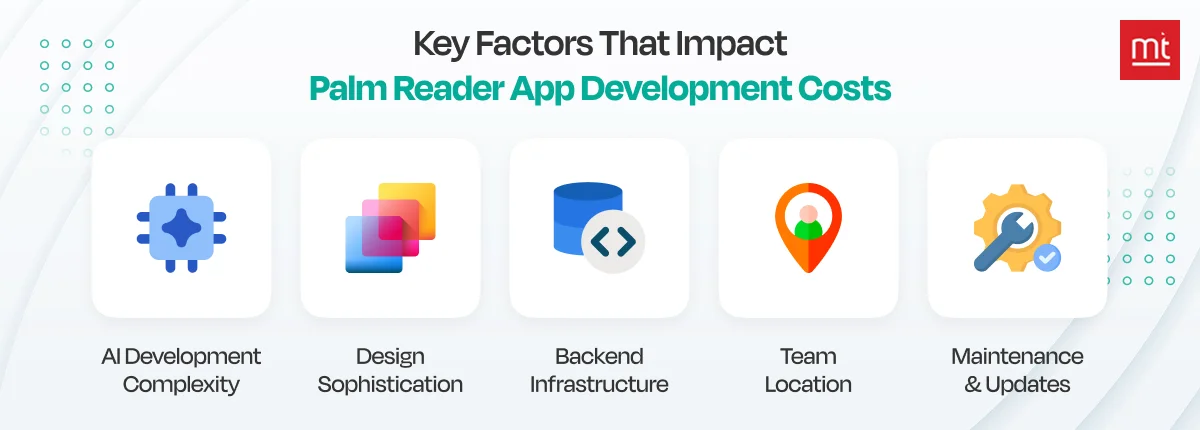
- AI Development Complexity: If you implement more advanced palm scanning and interpretation, you may need to create custom AI models and train them.
- Design Sophistication: If your app requires more animations, custom visuals, and detailed screens with a highly engaging interface, it will raise overall cost.
- Backend Infrastructure: Your backend has to be strong and secure, as it will handle user data, reports, and image processing; hence, features like cloud storage, real-time syncing, and security layers will add cost.
- Team Location: Where your development team is based impacts pricing. Developers in countries like the U.S. or the UK charge more, while teams in India or Eastern Europe can offer quality at an affordable cost.
- Maintenance & Updates: Ongoing maintenance can keep adding some extra costs with the evolving updates.
What Are Some Real-Time Case Studies of Palm Reading App Development? [Top Palm Reader App Like Life Palmistry]
Before you create your palm reading app your app, study the existing palm reading apps that are already successful. Below table of real-time case studies will give you an idea about how popular apps like Life Palmistry succeed with features, AI integration, and revenue strategies. So you can shape your app idea practically as per your business model.
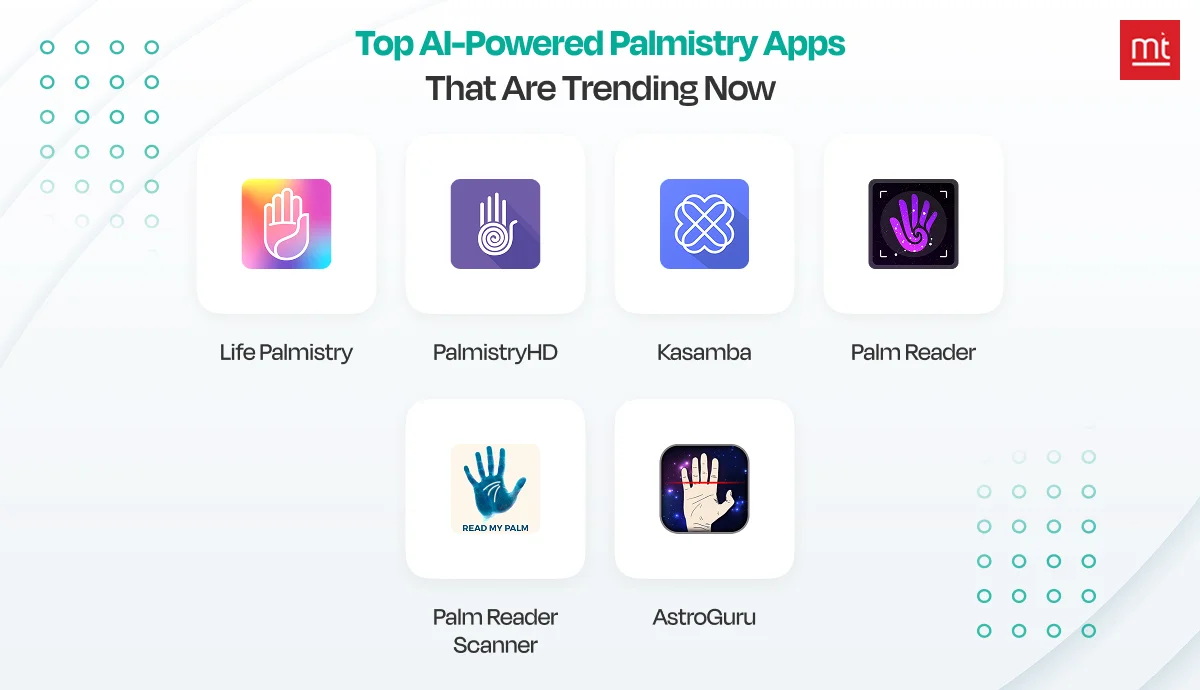
App Name | Key Features | Platform | Monetization |
Life Palmistry | - AI Palm Scanning | - Android | - In-app Purchases - Subscriptions |
PalmistryHD | - Palm Line Analysis - Horoscope - Love/Career/Health Readings | - Android | - Ads - Premium Readings |
Kasamba | - Live Psychic Chats - Palmistry - Tarot | - Android | - Pay-per-session |
Palm Reader - Scan Your Future | - Instant Palm Scan - Future Predictions - Playful UI | - Android | - Free with ads |
Palm Reader Scanner | - Fun Palm Readings | - Android | - Ads |
AstroGuru | - Palmistry + Astrology + Tarot | - Android | Freemium |
How Can ManekTech Help You Build a Palm Reader Application?
You can blindly trust Manektech for any kind of app development project. With 14 plus years of experience in the app development industry, we have constantly served some of the leading brands with high app stability and better ROI results. We follow an agile process, transparent coordination, with organized execution to fulfill tailored business goals.
If you want your palm reader app to succeed, choose our iOS app development services, we know how to design an engaging palm reader app for Apple users. With our wide project experience, skilled multi-domain teams, and flexible tech solutions, we are a capable and perfect fit for startups, mid-sized businesses, to enterprise businesses to take on any app development project. This is why global businesses trust us when they need to hire Android app developers capable of working with feature-rich applications.
Conclusion
If you are planning to build an AI palm reader app, every step matters. We hope this guide gave you a clear understanding of how to create a successful palmistry app. You must focus on essentials like market research, strong design, reliable AI, and effective monetization. Also prioritize user privacy, app performance, and continuous updates. These small details can make a big difference in building user trust and business growth.
If you are looking to build a powerful palm reader app, our experienced consultants can guide you to get started perfectly. Schedule a free consultation call to know what's possible.
FAQs: Palm Reader App Development
Q 1: What is a Palm Reader App like Life Palmistry?
Ans: The palm readers app, like palmistry, uses AI to interpret the handlines to provide insights to users related to personality, career paths, futur,e and other life-related decisions.
Q 2: How Does a Palm Reader App Use AI to Scan and Read Palms?
Ans: Palm reader apps use AI and image recognition technology with machine learning models to analyze the hand lines like heart lines, love lines, career lines, and more.
Q 3: Do I Need to Hire a Palmistry Expert for App Development?
Ans: You don't need a palmistry expert for app development, but they can offer useful insights by their knowledge and experience for accurate line interpretations, and train the AI models better.
Q 4: How Long Does It Take to Build a Palm Reading Mobile App?
Ans: It can usually take 3 to 6 months, depending on the complexity of palm reading features and the AI models and training needed.
Q 5: Is Ai-Based Palm Reading Scientifically Reliable?
Ans: AI-based palm readings are not 100% reliable or accurate, but it can analyze the lines' patterns and give interpretations based on how accurately the data is trained.
Q 6: What Are the Legal Concerns When Offering Palmistry Services in an App?
Ans: You need to give clear disclaimers that it’s for entertainment only. Plus, you must protect user data, follow privacy laws, and check if such services are allowed in your target region. Also, follow rules for in-app payments and age restrictions to stay compliant.
Q 7: How to Ensure Data Privacy in Palm Reading Apps?
Ans: Make sure the palm scans are encrypted and stored securely. You should also clearly explain how user data is used and make sure the app follows privacy laws like GDPR and CCPA.
Q 8: How to Retain Users in a Palm Reading App Long-Term?
Ans: Offer personalized daily or weekly predictions, send helpful reminders, and add fun, interactive features. Motivate users to try one on one consultation with palm reader experts. Plus, keep them updated with useful insights.
Q 9: How Can I Market My Palm Reader App to the Right Audience?
Ans: Palm reader app users are basically the people who believe in spirituality, wellness, and self-discovery. Here is how you can do that:
- Give a free trial to allow users to experience your palm reading app.
- Start by running targeted ads on platforms like Instagram, TikTok, and Facebook, using keywords like “daily horoscope,” “palmistry,” and “spiritual guidance.
- Collaborate with astrology influencers or spiritual content creators.
- Optimize your app store listing with relevant keywords, screenshots, and descriptions.
Subscribe to Our Newsletter!
Join us to stay updated with our latest blog updates, marketing tips, service tips, trends, news and announcements!



![How Much Does It Cost to Develop a Website in 2026? [Checklist]](https://www.manektech.com/storage/blog/image/1700562973.webp)
